Applied Interface Physics
Group of Prof. Markus Valtiner
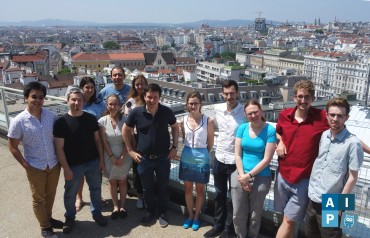 Our research focuses on the broad areas of adhesion, friction as well as interfacial forces and their utilization for making better energy-saving, energy efficient, cheaper, long lasting smart materials for application in structural and functional materials. We are also interested in dynamic interaction forces, single molecular interactions and soft matter physics in confined spaces. Our aim is to gain insight into the fundamental interactions in complex interfacial processes, and to translate fundamental science into knowledge-based design of better and novel structural and functional materials for technological applications. We are in particular interested in:
Our research focuses on the broad areas of adhesion, friction as well as interfacial forces and their utilization for making better energy-saving, energy efficient, cheaper, long lasting smart materials for application in structural and functional materials. We are also interested in dynamic interaction forces, single molecular interactions and soft matter physics in confined spaces. Our aim is to gain insight into the fundamental interactions in complex interfacial processes, and to translate fundamental science into knowledge-based design of better and novel structural and functional materials for technological applications. We are in particular interested in:
- Fundamental work on interfacial forces, interfacial structures and tribology under (electrochemically active) variable environmental conditions.
- The effect of (electro-)chemical reactions on interfacial interactions with a particular focus on structural effects in confined spaces and complex environments.
- Characterization of specific interactions and recognition in biologic systems
- Design of novel experiments for measuring surface forces
- Measurement, understanding and ultimately prediction of properties of surfaces, interfaces and thin films over large length and time scales.
- Design and utilization of model experiments and tunable thin films and interfaces using unique bio-mimetic and molecular design concepts.
- Development and establishment of new experimental techniques for surface and interface analysis.
- Preparation and characterization of advanced functional materials with smart properties.
- Corrosion and reactivity in confined spaces (crevice corrosion, SCC)
- Structuring of ionic liquids and solutions of ionic liquids at charged and uncharged interfaces
Recent work
ACS Applied Materials & Interfaces: Stability of (Photo-) Catalysts for the energy revolution
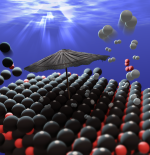 Electrochemical production of hydrogen from water is considered as an important step on our way to sustainable energies. Transparent semiconducting oxides like Zinc oxide can catalyse the water splitting reaction also using energy from light. This photoexcitation can not only help the water splitting reaction but also trigger photocorrosion.
With our approach of a photoelectrochemical flow cell with in-situ degradation product analysis (using ICP-MS) we looked at Zinc oxide crystals of different orientations during water splitting. We could show that the stability highly depends on pH of electrolyte and surface orientation. For certain conditions stabilizing structures on the surface prevent any dissolution of the catalyst. Ab initio calculations support those findings and thus can with high confidence be used to suggest suitable operating conditions for water splitting with both high efficiency and stability of the catalyst.
Electrochemical production of hydrogen from water is considered as an important step on our way to sustainable energies. Transparent semiconducting oxides like Zinc oxide can catalyse the water splitting reaction also using energy from light. This photoexcitation can not only help the water splitting reaction but also trigger photocorrosion.
With our approach of a photoelectrochemical flow cell with in-situ degradation product analysis (using ICP-MS) we looked at Zinc oxide crystals of different orientations during water splitting. We could show that the stability highly depends on pH of electrolyte and surface orientation. For certain conditions stabilizing structures on the surface prevent any dissolution of the catalyst. Ab initio calculations support those findings and thus can with high confidence be used to suggest suitable operating conditions for water splitting with both high efficiency and stability of the catalyst.
Read the freely available article at ACS.
Press release of TU Wien in english and german.
Advanced Science: Flexible solid electrolytes interfaces for more efficient batteries
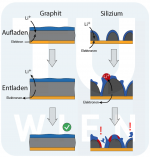 The interfacial decomposition products forming the so‐called solid–electrolyte interphase (SEI) significantly determine the destiny of a Li‐ion battery. Ultimate knowledge of its detailed behavior and better control are required for higher rates, longer life‐time, and increased safety. Employing an electrochemical surface force apparatus, it is possible to control the growth and to investigate the mechanical properties of an SEI in a lithium‐ion battery environment. This new approach is here introduced on a gold model system and reveals a compressible film at all stages of SEI growth. The demonstrated methodology provides a unique tool for analyzing electrochemical battery interfaces, in particular in view of alternative electrolyte formulations and artificial interfaces. The article is freely available from Advanced Science!
The interfacial decomposition products forming the so‐called solid–electrolyte interphase (SEI) significantly determine the destiny of a Li‐ion battery. Ultimate knowledge of its detailed behavior and better control are required for higher rates, longer life‐time, and increased safety. Employing an electrochemical surface force apparatus, it is possible to control the growth and to investigate the mechanical properties of an SEI in a lithium‐ion battery environment. This new approach is here introduced on a gold model system and reveals a compressible film at all stages of SEI growth. The demonstrated methodology provides a unique tool for analyzing electrochemical battery interfaces, in particular in view of alternative electrolyte formulations and artificial interfaces. The article is freely available from Advanced Science!
Read our press release here (german)and see an interview (in german) of Prof. Valtiner on the topic of battery safety.
LANGMUIR: Interaction Profiles and Stability of Rigid and Polymer-Tethered Lipid Bilayer Models at Highly Charged and Highly Adhesive Contacts
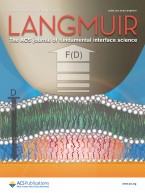 Understanding interaction force versus distance profiles of supported lipid bilayers is relevant to a number of areas, which rely on these model systems, including, e.g., characterization of ligand/receptor interactions or bacterial adhesion. We recently tested the stability of novel supported lipid bilayer architectures using the surface forces apparatus (SFA) and atomic force microscopy (AFM), specifically self-assembled monolayers (SAMs) of hexadecanethiol and the polymer-tethered diphytanylglycerol-tetraethylene glycol-lipoid acid (DPhyTL) on smooth gold surfaces where tested as support. Detachment profiles from highly charged and highly adhesive contacts were characterized, and approach characteristics were fitted to DLVO models. We find increasing stability under highly adhesive loads, approaching the hydrophobic limit of the adhesive energy between the inner and outer layers these systems. In addition, we find that undulation characteristics during approach and separation closely mimics natural flexible membranes for DPhyTL anchored systems. The increased stability of the complex architectures on a gold support makes these model systems an ideal starting point for studying more complex strongly adhesive/interacting systems, including, for example, ligand/receptor interactions, biosensing interactions, or cell/surface interactions.
Understanding interaction force versus distance profiles of supported lipid bilayers is relevant to a number of areas, which rely on these model systems, including, e.g., characterization of ligand/receptor interactions or bacterial adhesion. We recently tested the stability of novel supported lipid bilayer architectures using the surface forces apparatus (SFA) and atomic force microscopy (AFM), specifically self-assembled monolayers (SAMs) of hexadecanethiol and the polymer-tethered diphytanylglycerol-tetraethylene glycol-lipoid acid (DPhyTL) on smooth gold surfaces where tested as support. Detachment profiles from highly charged and highly adhesive contacts were characterized, and approach characteristics were fitted to DLVO models. We find increasing stability under highly adhesive loads, approaching the hydrophobic limit of the adhesive energy between the inner and outer layers these systems. In addition, we find that undulation characteristics during approach and separation closely mimics natural flexible membranes for DPhyTL anchored systems. The increased stability of the complex architectures on a gold support makes these model systems an ideal starting point for studying more complex strongly adhesive/interacting systems, including, for example, ligand/receptor interactions, biosensing interactions, or cell/surface interactions.
FEATURED: Optimizing multiple beam interferometry in the surface forces apparatus: Novel optics, reflection mode modeling, metal layer thicknesses, birefringence, and rotation of anisotropic layers (open access article)
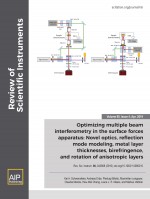 Multiple beam interferometry (MBI) evolved as a powerful tool for the simultaneous evaluation of thin film thicknesses and refractive indices in Surface Forces Apparatus (SFA) measurements. However, analysis has relied on simplifications for providing fast or simplified analysis of recorded interference spectra. Here, we describe the implementation of new optics and a generalized fitting approach to 4 × 4 transfer matrix method simulations for the SFA. The newly developed optical layout for SFA, which greatly simplifies operation, introduces reference beams, allows recording of reflection and transmission mode spectra, and minimizes potential systematic errors in experiments and analysis. This approach greatly simplifies SFA experimentation and analysis and opens SFA for new and exciting opportunities, including metamaterials, multilayered anisotropic layers, layers of rotating anisotropic layer, as well as chiral layers. FREE DOWNLOAD from Rev. Sci. Instr..
Multiple beam interferometry (MBI) evolved as a powerful tool for the simultaneous evaluation of thin film thicknesses and refractive indices in Surface Forces Apparatus (SFA) measurements. However, analysis has relied on simplifications for providing fast or simplified analysis of recorded interference spectra. Here, we describe the implementation of new optics and a generalized fitting approach to 4 × 4 transfer matrix method simulations for the SFA. The newly developed optical layout for SFA, which greatly simplifies operation, introduces reference beams, allows recording of reflection and transmission mode spectra, and minimizes potential systematic errors in experiments and analysis. This approach greatly simplifies SFA experimentation and analysis and opens SFA for new and exciting opportunities, including metamaterials, multilayered anisotropic layers, layers of rotating anisotropic layer, as well as chiral layers. FREE DOWNLOAD from Rev. Sci. Instr..
In situ nano- to microscopic imaging and growth mechanism of electrochemical dissolution (e.g., corrosion) of a confined metal surface
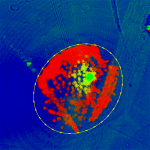 Reactivity in confinement is central to a wide range of applications and systems, yet it is notoriously difficult to probe reactions in confined spaces in real time. Using a modified electrochemical surface forces apparatus (EC-SFA) on confined metallic surfaces, we observe in situ nano- to microscale dissolution and pit formation in well-defined geometries in environments relevant to corrosion processes. Read more in PNAS.
Reactivity in confinement is central to a wide range of applications and systems, yet it is notoriously difficult to probe reactions in confined spaces in real time. Using a modified electrochemical surface forces apparatus (EC-SFA) on confined metallic surfaces, we observe in situ nano- to microscale dissolution and pit formation in well-defined geometries in environments relevant to corrosion processes. Read more in PNAS.
One molecule at the time: Probing surface-to-molecule bonds - Bias and work dissipation (Open access article)
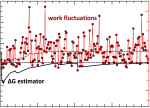 The capabilities of Atomic Force Microscopes and Optical Tweezers to probe unfolding or surface-to-molecule bond rupture at a single-molecular level are widely appreciated. Our recent results provide new insights into stability and work dissipation mechanisms at adhesive interfaces at the single-molecular level, and offer important design and analysis aspects for single-molecular surface-to-molecule experiments. Want to know more? Read our article (OPEN ACCESS) in this Langmuir special issue.
The capabilities of Atomic Force Microscopes and Optical Tweezers to probe unfolding or surface-to-molecule bond rupture at a single-molecular level are widely appreciated. Our recent results provide new insights into stability and work dissipation mechanisms at adhesive interfaces at the single-molecular level, and offer important design and analysis aspects for single-molecular surface-to-molecule experiments. Want to know more? Read our article (OPEN ACCESS) in this Langmuir special issue.
Group news
Welkom bij ons, Matteo
 Matteo Olgiati joins our team after his Master in Delft. He will be working on in-situ investigations on electrochemical systems related to e.g. catalysis and corrosion.
Welcome Matteo!
Matteo Olgiati joins our team after his Master in Delft. He will be working on in-situ investigations on electrochemical systems related to e.g. catalysis and corrosion.
Welcome Matteo!
Valentina wins Franz Viehböck Young Investigator Poster Prize

With her poster 'From Measuring Gold|Gold to Protein Interaction' Valentina Wieser could convince the jury. (oral presentation and further information on the prize can be found here)
Congratulations, Valentina!
It's Krapfen time
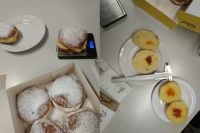
2020-01
Since the temperatures in Vienna suggest the spring time might be approaching, we hurried to celebrate the Krapfenzeit. On that occassion, we set to determine the perfect amount of apricot jam inside. We hope to see our results published soon…
Hui reinforces our team

We are delighted to welcome Hui Yuan as a visiting PhD student in our group. Hui joins us form Tianjin University, Tianjin, China and is working on friction and lubrication relevant to biological systems, using the surface force apparatus. We are happy to have you here, Hui!
IAP Christmas Party 2019
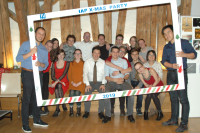
2019-12
It was a pleasure for our group to organize this years christmas party of the institute. It contained: a donkey, a flock of chicken, a goat and even dancing physicist, thanks to our amazing band Teddy Bear Cove.
Merry Christmas!
Drawing contest
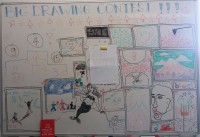 Our group organized a drawing contest open to anyone who came into the kitchen. Sixteen artists anonymously showcased their skills and a panel of experts
Our group organized a drawing contest open to anyone who came into the kitchen. Sixteen artists anonymously showcased their skills and a panel of experts in physics voted for their favorites. With the help of our friends from Computational Physics, who implemented a sophisticated vote-evaluating algorithm, we can now name a winner for best picture:
Number 4 by Joanna!
PhD for Laila
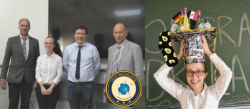 Laila Moreno Ostertag successfully defended her dissertation 'Decoding sigle-molecular reactions and interactions at solid/liquuid interfaces'. With her enourmous vocabulary in a variety of languages our group looses with Laila leaving also our Lead Translator. All the best for your future, Laila!
Laila Moreno Ostertag successfully defended her dissertation 'Decoding sigle-molecular reactions and interactions at solid/liquuid interfaces'. With her enourmous vocabulary in a variety of languages our group looses with Laila leaving also our Lead Translator. All the best for your future, Laila!
Shiny basement with Ben
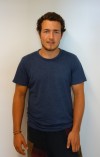 We are happy to welcome Ben Stephani to our group. In his bachelor thesis he is working on finishing our Physical Vapor Deposition (PVD) together with Dr. William Cheng. This machine is essential for many of our experiments since it makes us possible to create thin and flat metal films, a good model system for surfaces in general.
Welcome Ben!
We are happy to welcome Ben Stephani to our group. In his bachelor thesis he is working on finishing our Physical Vapor Deposition (PVD) together with Dr. William Cheng. This machine is essential for many of our experiments since it makes us possible to create thin and flat metal films, a good model system for surfaces in general.
Welcome Ben!
Exploring landscapes with Alexander
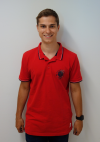 With Alexander Imre we have a new project student. Supervised by Ulrich Ramach and Julia Appenroth Alex does electrochemical studies on L-DOPA to widen our insights into the molecules energy landscape.
This is expanding the work that has been started with Laila Moreno Ostertag. Nice to have you, Alex!
With Alexander Imre we have a new project student. Supervised by Ulrich Ramach and Julia Appenroth Alex does electrochemical studies on L-DOPA to widen our insights into the molecules energy landscape.
This is expanding the work that has been started with Laila Moreno Ostertag. Nice to have you, Alex!
Holiday season?!
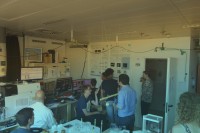 Even now seems to be a perfect time of the year to go on holiday our lab is crowded as never before. So temperatures are rising not just outside, but also in our lab.
Happy holiday season!
Even now seems to be a perfect time of the year to go on holiday our lab is crowded as never before. So temperatures are rising not just outside, but also in our lab.
Happy holiday season!
New bachelor student Milena
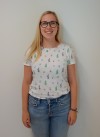 Milena Zehetner joins our bio-related subgroup as a bachelor student. She studies the properties of glue obtained from ticks, supervised by Laura Mears. This is a promising material for bio-compatible applications for example in surgery. Nice to have you here, Milena!
Milena Zehetner joins our bio-related subgroup as a bachelor student. She studies the properties of glue obtained from ticks, supervised by Laura Mears. This is a promising material for bio-compatible applications for example in surgery. Nice to have you here, Milena!
Martin starting
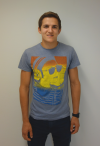 With Martin Wess joining we enlarge our corrosion team. In cooperation with Berndorf Band and supported by the FFG he works on material degradation of stainless steels. Welcome Martin!
With Martin Wess joining we enlarge our corrosion team. In cooperation with Berndorf Band and supported by the FFG he works on material degradation of stainless steels. Welcome Martin!
Joanna Joining
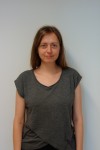 We are happy to welcome our new Postdoc, Joanna Dziadkowiec. She will work on electrochemical corrosion, growth and friction of confined, reactive mineral surfaces. Her project is in collaboration with the Njord Centre at the University of Oslo, funded by the Research Council of Norway (FRINATEK Mobility). Nice to have you here!
We are happy to welcome our new Postdoc, Joanna Dziadkowiec. She will work on electrochemical corrosion, growth and friction of confined, reactive mineral surfaces. Her project is in collaboration with the Njord Centre at the University of Oslo, funded by the Research Council of Norway (FRINATEK Mobility). Nice to have you here!
'Current event'
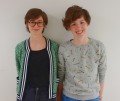 Our electrochemistry department got new members: With Sonja Scherhaufer and Valentina Wieser we welcome our first Bachelor students.
Valentina will work on the electrochemical version of our Surface Force Apparatus (SFA) under the supervision of William. Sonja does electrochemical characterization of dopamine and other catechol derivates, supported by Laila. Welcome!
Our electrochemistry department got new members: With Sonja Scherhaufer and Valentina Wieser we welcome our first Bachelor students.
Valentina will work on the electrochemical version of our Surface Force Apparatus (SFA) under the supervision of William. Sonja does electrochemical characterization of dopamine and other catechol derivates, supported by Laila. Welcome!
PhD students +1, Austrians +1
 With Ulrich Ramach joining we widen our research more to the bio direction. In his PhD Uli wants to gain insights into ion channels and proteins for biosensing. His work is done in collaboration with CEST.
Welcome Uli!
With Ulrich Ramach joining we widen our research more to the bio direction. In his PhD Uli wants to gain insights into ion channels and proteins for biosensing. His work is done in collaboration with CEST.
Welcome Uli!
New faces in the group

 We are happy to welcome two new persons among us. Florian Feldmann is doing his PhD with both us and the company Dörken MKS. He will characterize corrosion protection coatings based on zinc lamellae. Adél Racz is doing her PhD at the Hungarian Academy of Sciences Centre for Energy Research and doing a scholarship with the OeAD. She brought Carbides produced by radiation to characterize their tribologic properties.
We are happy to welcome two new persons among us. Florian Feldmann is doing his PhD with both us and the company Dörken MKS. He will characterize corrosion protection coatings based on zinc lamellae. Adél Racz is doing her PhD at the Hungarian Academy of Sciences Centre for Energy Research and doing a scholarship with the OeAD. She brought Carbides produced by radiation to characterize their tribologic properties.
Welcome Flo and Adél!
Carnival 2019
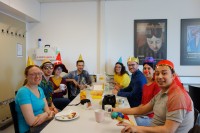 According to an order by the institute director we dressed up for Carneval today. Since some parts of our group used to live in Düsseldorf in the past (which is one on Germany's hotspots in this matter) it was easy for us to comply with that rule. Krapfen complemented the atmosphere.
According to an order by the institute director we dressed up for Carneval today. Since some parts of our group used to live in Düsseldorf in the past (which is one on Germany's hotspots in this matter) it was easy for us to comply with that rule. Krapfen complemented the atmosphere.
Group Retreat in Slovakia
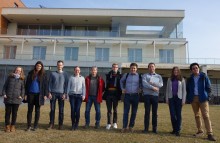 5th floor of Freihaus is less crowded these days since we are on our group retreat in the rural part of Bratislava, Slovakia. Apart from rich discussions about our current and future research we also enjoy the time together on walks and sports. Thanks to Laura, who took over the organisation of our trip!
5th floor of Freihaus is less crowded these days since we are on our group retreat in the rural part of Bratislava, Slovakia. Apart from rich discussions about our current and future research we also enjoy the time together on walks and sports. Thanks to Laura, who took over the organisation of our trip!
Group is getting more austrian
 We are happy to welcome our new group member Julia Appenroth. She is working on single-molecule adhesion and on scaling it up to peptide-based mussel glue mimics. She will collaborate with our colleagues at both CEST and JKU Linz. Welcome to our group!
We are happy to welcome our new group member Julia Appenroth. She is working on single-molecule adhesion and on scaling it up to peptide-based mussel glue mimics. She will collaborate with our colleagues at both CEST and JKU Linz. Welcome to our group!
TU Ball preparations
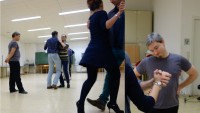 Under the critical eyes of our dancing teacher Kai Schwenzfeier we were able to improve our skills in moving feet and body to music.
Apart from minor injuries the class was quite successful and the group is looking forward to dance all night long at the upcoming TU Ball.
See you there!
Under the critical eyes of our dancing teacher Kai Schwenzfeier we were able to improve our skills in moving feet and body to music.
Apart from minor injuries the class was quite successful and the group is looking forward to dance all night long at the upcoming TU Ball.
See you there!
PhD for Claudia
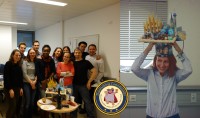 Claudia Merola successfully defended her dissertation about corrosion in confinement. Thanks to her we understand the corrosion of nickel and its alloys much better. Apart from being a hardworking PhD student Claudia also served as our Teambuilding Commissioner. Thank you for that!
Claudia Merola successfully defended her dissertation about corrosion in confinement. Thanks to her we understand the corrosion of nickel and its alloys much better. Apart from being a hardworking PhD student Claudia also served as our Teambuilding Commissioner. Thank you for that!
Ti auguriamo il meglio per il tuo avvenire!
Max finishes Master
 Congratulations to Max Lengauer, who succesfully defended his master's thesis recently. He helped us to develop model lipid bilayer systems under high adhesion. As our gourmet manager he always had a good nose for fancy cuisine. We wish him well for his future studies!
Congratulations to Max Lengauer, who succesfully defended his master's thesis recently. He helped us to develop model lipid bilayer systems under high adhesion. As our gourmet manager he always had a good nose for fancy cuisine. We wish him well for his future studies!
PhD support from industry
 We are happy to welcome our new PhD student Gastelle Tiétcha, who just recently joined our group. She works on coatings for corrosion protections. Her PhD is conducted in close collaboration with Dörken MKS from Herdecke, Germany. Welcome, Gastelle!
We are happy to welcome our new PhD student Gastelle Tiétcha, who just recently joined our group. She works on coatings for corrosion protections. Her PhD is conducted in close collaboration with Dörken MKS from Herdecke, Germany. Welcome, Gastelle!
First Project Student
 Christian Cupak supports our group as a project student. He is going to build up a device for measuring adhesion used for characterizing e.g. biological adhesives. Welcome to the AIP group!
Christian Cupak supports our group as a project student. He is going to build up a device for measuring adhesion used for characterizing e.g. biological adhesives. Welcome to the AIP group!
Inaugural Lecture
 With his inaugural lecture Univ.Prof. Dr. Markus Valtiner officially started teaching at Vienna University of Technology.
In front of interested colleagues, industry and university representatives, friends and family he gave an pleasing overview of his groups research activities.
With his inaugural lecture Univ.Prof. Dr. Markus Valtiner officially started teaching at Vienna University of Technology.
In front of interested colleagues, industry and university representatives, friends and family he gave an pleasing overview of his groups research activities.
AIP group vs. Particles 1:0
 Many of our experiments we do require special awareness of contaminations. After an intensive clean room training we started to tidy our lab and make it ready to be run as a clean room. The motto is: Don't give dust a chance.
Many of our experiments we do require special awareness of contaminations. After an intensive clean room training we started to tidy our lab and make it ready to be run as a clean room. The motto is: Don't give dust a chance.
Teambuilding activities
 For enhancing our team spirit we sometimes spend some time together even on holidays. Here a picture from our last teambuilding activity on May 31st.
For enhancing our team spirit we sometimes spend some time together even on holidays. Here a picture from our last teambuilding activity on May 31st.
Nice weather from the UK
 The arrival of our new Postdoc Laura Mears coincided with beginning of spring in Vienna. Laura brought the pleasant temperatures from the University of Liverpool.
Welcome to our group!
The arrival of our new Postdoc Laura Mears coincided with beginning of spring in Vienna. Laura brought the pleasant temperatures from the University of Liverpool.
Welcome to our group!
We are hiring!
Together with our collaboration partner from Medical University of Vienna we are hiring a master student (f/m) in the field of tissue glueing - start date asap - check the offer here!
Group finally reunited
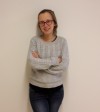 With Laila Moreno Ostertag joining us from Max-Planck-Institut für Eisenforschung in Düsseldorf, Germany, our group is finally completely reunited. As a PhD student Laila is working on single-molecule experiments to elucidate adhesive interactions. Welcome to Vienna!
With Laila Moreno Ostertag joining us from Max-Planck-Institut für Eisenforschung in Düsseldorf, Germany, our group is finally completely reunited. As a PhD student Laila is working on single-molecule experiments to elucidate adhesive interactions. Welcome to Vienna!
Title series #1: Lab Executive
 Our international group realized that in Austria titles are highly prestigious.
In order to retrace this culture our group came up with own titles.
At random intervals we present some of our functions.
After 4 month as a Laboratory Executive Dominik Dworschak passed his responsibility to Pierluigi Bilotto. He will hold this office in February. His tasks are among others to keep the lab clean and order consumables.
Our international group realized that in Austria titles are highly prestigious.
In order to retrace this culture our group came up with own titles.
At random intervals we present some of our functions.
After 4 month as a Laboratory Executive Dominik Dworschak passed his responsibility to Pierluigi Bilotto. He will hold this office in February. His tasks are among others to keep the lab clean and order consumables.
Growth of our Group
 Claudia Merola joined our group from Max-Planck-Institut für Eisenforschung in Düsseldorf, Germany. In her PhD thesis she deals with better understanding of the beginning stage of crevice corrosion. Welcome to Vienna!
Claudia Merola joined our group from Max-Planck-Institut für Eisenforschung in Düsseldorf, Germany. In her PhD thesis she deals with better understanding of the beginning stage of crevice corrosion. Welcome to Vienna!
Our first Master students
 We are very happy to welcome our first Master students.
Maximilian Lengauer is a student of physics at TU and deals with lipid bilayers.
Yana De Smet from Hasselt University reached us via the Erasmus Programme. She works on biomineralization of calcium phosphates.
Welcome to our group, Max and Yana!
We are very happy to welcome our first Master students.
Maximilian Lengauer is a student of physics at TU and deals with lipid bilayers.
Yana De Smet from Hasselt University reached us via the Erasmus Programme. She works on biomineralization of calcium phosphates.
Welcome to our group, Max and Yana!
Beam time in Taiwan
 Our Postdoc William Cheng was in Taiwan working with our new X-SFA. Together with Frank Uwe Renner (Hasselt University) and Claudia Merola (Max-Planck-Institut für Eisenforschung) he performed experiments at National Synchrotron Radiation Research Center. Stay tuned for the results!
Our Postdoc William Cheng was in Taiwan working with our new X-SFA. Together with Frank Uwe Renner (Hasselt University) and Claudia Merola (Max-Planck-Institut für Eisenforschung) he performed experiments at National Synchrotron Radiation Research Center. Stay tuned for the results!


